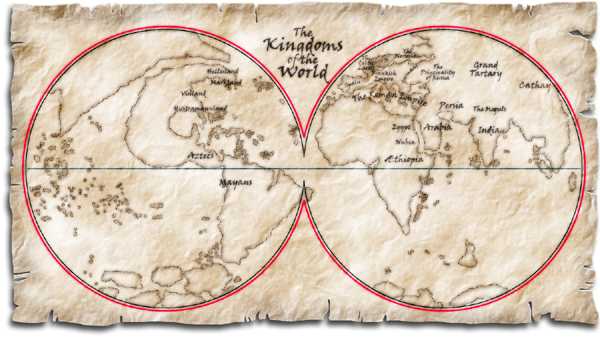
The players' precious map of the Known World. For those who are interested, the map is based on a real one which was drawn around 1520 by a chap called Schöner. Click here for a PDF version of the map above showing general cultural distributions (aprox. 90 kilobytes).
Back to the Fantasy Campaign pages
The campaign is based in an alternative Earth milieu from a primarily European / Middle Eastern perspective. The level of technology is set at that which existed about the year AD 1450, though the racial and political divisions are more like those appertaining around AD 600. At present, the area in which the game takes place is Eastern Europe, though knowing players' propensities for haring off to the ends of the earth after red herrings, that may very well change in the future. Hopefully not until I've actually prepared some resource materials about other parts of the world.
European History in Brief
Julius Cæsars's invasion of Britain was never followed up by Claudius, and Britain was not therefore thoroughly Romanized. Rome's resources were instead devoted to the pacification and control of the Germans, to the extent that in the present day, the area controlled by independent Germanic tribes is tiny, most of Germany being incorporated into the Frankish Empire. Germanic peoples from the north — Angles, Saxons, Jutes and Frisians — were pushed out of their lands by Roman expansion, and settled in Britain, pushing the Celts out into the north and west. With Roman retrenchment and withdrawal from northern Europe, Norse settlers came south, settling in northern Gaul as Frankish kings exerted their control over the abandoned Roman territories. Other Scandinavians, mostly from Sweden, expanded into the vast country of the Slavs, founding the principalities of Russia. William the Norman's invasion of England was beaten off at the Battle of Hastings, leaving the Anglo-Saxon aristocracy in control.
The Roman Empire is now centred on Constantinople, and the city of Rome itself is a degraded village under the domination of Ostrogothic invaders. The Christian church is highly fragmented into a multitude of sects, the largest and most important being the official Greek Orthodox of the Byzantine Empire. Islam, also somewhat fragmented, has spread east through Persia, Afghanistan and northern India, and south into Arabia, but has made few inroads to the west. Most of Europe (and the rest of the world, for that matter) is pagan and pantheistic.
Viking settlements along the eastern coast of the North American continent thrive and have developed into stable nations, and they have reasonably regular contact with the Aztec and Mayan empires to the south. There is a (small) degree of commerce between Europe and the Americas, though a journey across the Atlantic is fraught with peril. The Pacific rim is pretty much Terra Incognita to Europeans — it is known that a huge ocean exists there, but reliable reports of it are non-existant.
 border="0">
border="0">
NOTE: The main reason for choosing an alternative historical Earth milieu is because it means a lot less work for me - lots of maps and pictorial resources already exist. It also means that I don't have to make up societies and mythologies which basically mirror real ones; I just use the real ones. I could just have used a non-alternate late medieval Europe, but I really wanted a milieu with a reasonably advanced (pre-industrial) technological base, but without the overwhelming dominance of monotheistic religions of the real world.

 border="0">
border="0">